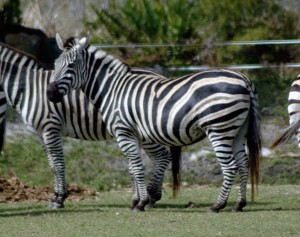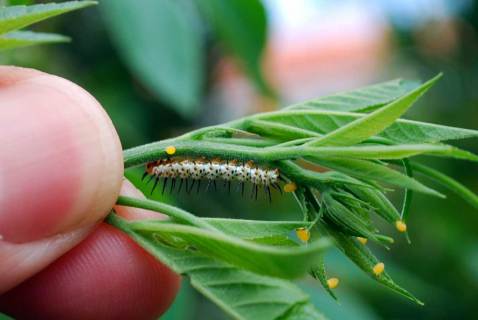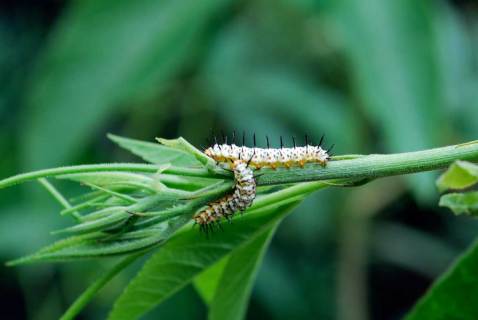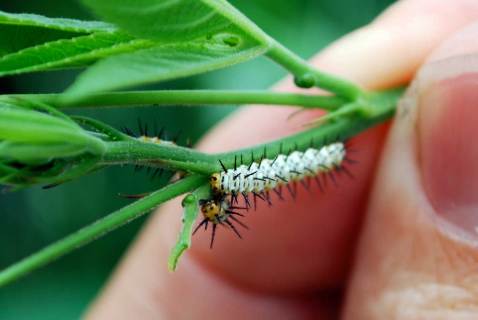Back around Labor Day I wrote a couple of short pieces about the various egg-laying episodes I’ve seen on the hybrid passionvine in our back yard. This particular plant is a cross between our native Passiflora incarnata and a Mexican variety, thus explaining why our “3-lobed” native has 5-lobed leaves. The star of the September post was our state butterfly, the Zebra Heliconian (Heliconius charithonia); in that article I showed a few pictures of the adult form and the eggs. But I wasn’t able to hit for the cycle—the life cycle, that is—meaning showing photos of egg, larva, chrysalis, and adult. I posted the pictures I had: the adult butterfly and the egg. While I still haven’t got the complete cycle, I’m only missing the triple, because today I got the double: a good photo of the larval form, the caterpillar.
While it’s true that passionvines have developed some chemical defenses against herbivory, the heliconians have outsmarted the plants, incorporating those chemical defenses into their own chemical defenses against lepidivory (to coin a term). And now there are quite a few heliconian caterpillars (all Zebras) on the vine. Here’s what initially attracted my attention:
Isn’t it an interesting caterpillar? White body with black spots and black spines all over the body. According to Minno et al, the eggs are laid singly, but several other sources agree that the eggs are laid in clusters. That is, they’re not in rafts, each egg touching the next, but they are laid in loose aggregations. I suppose the authors are technically accurate, but for a lay audience the phrase “singly” is a bit misleading.
The photo above was taken with an older lens that doesn’t allow me to get as close to the subject as I’d like. While it has a nominally “better” zoom factor (80mm) than the lens in the photos below (zooms “only” to 55mm), the newer lens has a much closer focal point, so you don’t need anywhere near as much zoom. This find was so exciting that I went back in the house to get the newer lens; it’s hard to describe how much better the close-focus lens works, so I’ll just let the pictures speak for themselves.
Here’s a “thumbnail” shot of a single caterpillar and a few eggs:
Did you notice the “holes” running along the length of the animal? If you look closely, you’ll see that there is one “hole” per abdominal segment, except for the first two segments. These holes are called spiracles and they allow the caterpillar to breathe. On some species, the last pair of holes is larger than the others, as they have to supply the entire posterior of the animal with oxygen while the others only have to supply their own individual segment.
Here is a pair of Zebra larvae. I don’t think they’re trying to eat each other (these caterpillars are not described as being cannibalistic, unlike Giant Swallowtail larvae), but they certainly do look like they’re in close communion:
And here is the by-now traditional thumb shot of the pair:
If you clicked any of the pictures above for the larger version, you probably noticed that these caterpillars have yellow heads. Here again Minno et al’s description of the caterpillar is a bit misleading; they say that the head is white. This must be a variable character, because it’s clearly yellow in the photos.
Did you also notice the color of the spots on the bodies? Some larvae have black spots while others have brown. I wonder if that’s a function of age, or sex, or some other character, or it might just be random. Do younger larvae have brown spots that deepen to black (or vice versa)? Or do females, which I believe are browner than the males as adults, have the brown spots, while the male caterpillars have black? (I’ve not been able to find a reference that confirms my hunch that female adults are browner than males, but I thought I read it somewhere…)
One interesting thing about the adult form of this butterfly is that it is relatively long lived. While other butterflies feed on nectar alone, the Zebra (and other heliconians as well) supplements its diet with pollen. Apparently this richer food source enables the Zebra to live for several months, rather than the days to weeks of other types of butterfly.
Hooray for Heliconius! Hooray for Zebras!

No, not that kind of zebra. This kind:



